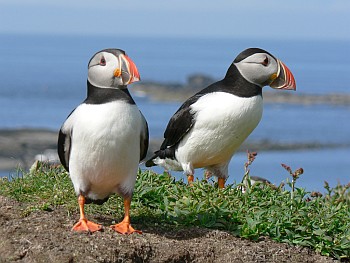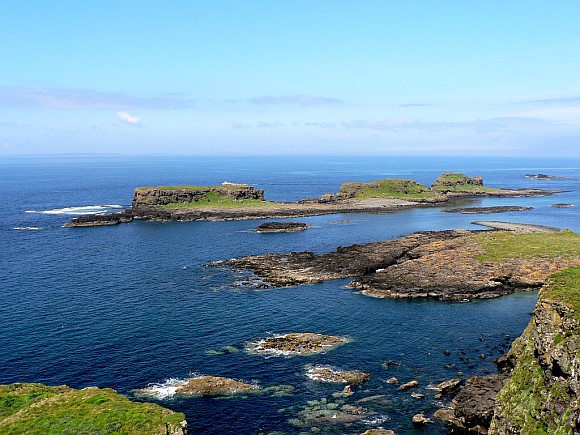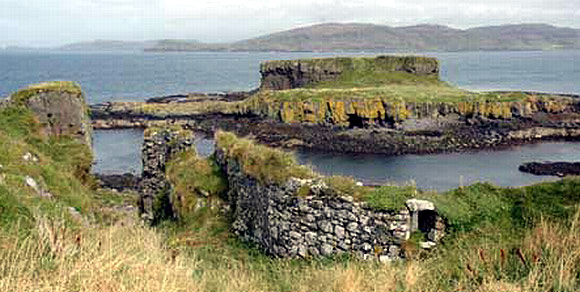 The Treshnish Isles, an archipelago of several small islands, can be found off the south west coast of Mull and are best visible near Treshnish Point or Port Haunn, south of Calgary Bay. Also from Loch Tuath on Mull looking west the islands are visible on a clear day, specially due to the distinctive shape of some of the islands such as Bac Mor which is also known as the Dutchman’s Cap. The islands have been landmarks for travellers through the Hebrides for at least 1000 years. The names of some of the islands still reflect their importance to the Vikings who once ruled in the Hebrides. The islands, and Cairnburgh Castle in particular, had a strong strategic position well into the 1800s.
The Treshnish Isles, an archipelago of several small islands, can be found off the south west coast of Mull and are best visible near Treshnish Point or Port Haunn, south of Calgary Bay. Also from Loch Tuath on Mull looking west the islands are visible on a clear day, specially due to the distinctive shape of some of the islands such as Bac Mor which is also known as the Dutchman’s Cap. The islands have been landmarks for travellers through the Hebrides for at least 1000 years. The names of some of the islands still reflect their importance to the Vikings who once ruled in the Hebrides. The islands, and Cairnburgh Castle in particular, had a strong strategic position well into the 1800s.
The Treshnish Isles are formed from 8 principal islands varying in size from less than 4 hectares to 60 hectares. The archipelago lies, at its closest, 3 km west of Mull and extends along a northeast-southwest axis for a distance of 11 km. The islands are uninhabited but that wasn’t always the case, hill forts, medieval chapels and castles prove that humans were once permanently living on these remote and unsheltered islands. The population in 1800 on Lunga was about 20. Year-round occupation ended in 1824 when Donald Campbell and his family left the island.

Bac Mor -Dutchman’s Cap seen from Lunga
The larger Treshnish islands are Cairn na Burgh Beg, Fladda, Lunga, Bac Mòr (Dutchman’s Cap) and Bac Beag and there are several other smaller islands in between. Lunga is the largest island and has the highest mountain, Cruachan, which is 103 metres high and can be found on the northern part of the island while Bac Mor, further south, has a mountain of 86 metres.
 The Treshnish Isles are one of the most scenically evocative features of the Hebridean landscape. The islands are exposed to the open ocean, uninhabited and have no good landing sites, hence the presence of vibrant wildlife communities. The Treshnish Isles possess unique landscape, rich wildlife communities and contain habitat, which is vital for several vulnerable species. They have an archaeological history dating from early Viking times. The islands already have international recognition of their heritage value. They are designated as a Site of Special Scientific Interest (Wildlife and Countryside Act 1981) because of their unique geomorphology, populations of seals, cliff- and burrow-nesting seabirds, wintering wildfowl and populations of house mice. They have also recently been designated as a Special Protection Area under the EC Directive (79/409) on the Conservation of Wild Birds.
The Treshnish Isles are one of the most scenically evocative features of the Hebridean landscape. The islands are exposed to the open ocean, uninhabited and have no good landing sites, hence the presence of vibrant wildlife communities. The Treshnish Isles possess unique landscape, rich wildlife communities and contain habitat, which is vital for several vulnerable species. They have an archaeological history dating from early Viking times. The islands already have international recognition of their heritage value. They are designated as a Site of Special Scientific Interest (Wildlife and Countryside Act 1981) because of their unique geomorphology, populations of seals, cliff- and burrow-nesting seabirds, wintering wildfowl and populations of house mice. They have also recently been designated as a Special Protection Area under the EC Directive (79/409) on the Conservation of Wild Birds.

Treshnish Isles Bac Mor (Dutchman’s Cap)
Lunga has one of the most varied and accessible seabird colonies on the Western Seaboard. Dun Cruit (the Harp Rock stack), is home to more than 6,000 guillemot, razorbill, puffin, kittiwake, fulmar, shag, skua and many more. Puffins spend most of the year at sea and breed from April to July and leave again in early August. The puffins on Lunga are not afraid of people which gives ideal opportunities for photography. Lunga is also an important breeding ground for Grey Seals. Since 1971, the Treshnish Isles Auk Ringing Group has monitored, through ringing and census work, the breeding sea bird populations of the Treshnish Isles, Argyll. Annual reports have been produced each year since and are available from the Hebridean Trust website.

Treshnish Isles looking north from Lunga to Sgeir a Chaisteil
The Medieval history of the Treshnish Islands focuses on the castle of Cairnburgh, which occupies the adjacent islands of Cairn na Burgh More and Cairn na Burgh Beg. The earliest reference to the castle appears in a Norse saga ‘the saga of Hakon Hakon’s son’ which was composed sometime in the second half of the thirteenth century. This saga tells us that King Hakon of Norway assigned Cairnburgh Castle to Ewan MacDougall, lord of Lorn or Argyll, in 1249. After 1266, the treaty of Perth, the Scottish Crown continued to regard Cairnburgh as a royal castle and it remained in the hands of the MacDougalls of Lorn. In 1354 the castle as well as the Treshnish Isles themselves, came into the hands of the MacDonald, Lords of the Isles, who ruled the west of Scotland from Finlaggan Islay. Later the castle was restored to the MacLeans. From the late fifteenth century to the late seventeenth century, possession of the Treshnish Isles remained, on the whole, with the MacLeans until in the late 1700s the castle was abandoned. Nowadays the Tresnish Isles are owned by the Hebridean Trust who completed the purchase of the islands in April 2000.
Access to the isles is possible in the summer, weather permitting. Boat trips are run from Oban or closer by from Mull (Fionnport), Ulva Ferry and Iona. Check the cruises and wildlife tours page for details.
 More info:
More info:
Treshnish Isles Map – A detailed map of the island

Treshnish Isles castle ruins
Copyright notice: Image 1/4 courtesy senninha, image 2/3 courtesy of Tony Page